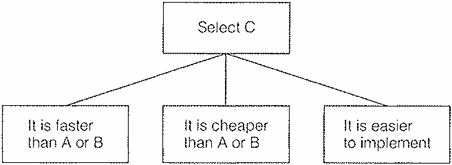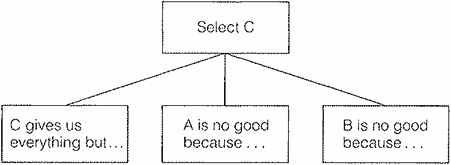
Choosing Among Alternatives
 المؤلف:
BARBARA MINTO
المؤلف:
BARBARA MINTO
 المصدر:
THE MINTO PYRAMID PRINCIPLE
المصدر:
THE MINTO PYRAMID PRINCIPLE
 الجزء والصفحة:
54-3
الجزء والصفحة:
54-3
 2024-09-11
2024-09-11
 790
790
Choosing Among Alternatives
Frequently managers ask their subordinates to analyze a problem and come up with a solution, adding 'And let me see your alternatives." Strictly speaking, as you will see when we discuss problem definition, there is no such thing as an alternative solution to a problem, provided the problem has been properly defined. Either what you recommend will solve the problem or it will not, and in that sense there are no alternatives.
What the manager actually means is “Give me an idea of the different things we could try if you cannot devise a solution that totally solves the problem as we have defined it." Thus the only time you should have to write a memo that deals with genuine alternatives is when they are known by the reader in advance, probably because they have been under discussion in the company. In that case the introduction is very easy to structure:
S = We want to do X
C = We have alternative ways of doing it
Q = Which one makes the most sense?
Or to put meat on it:
S = As you know, the recent ruling that a 5-105 HP motor is the most efficient for drilling oil in cold temperatures has led our largest customer to announce that he will switch from using our 10 HP motor to our competitor's 7 HP model.
C = We have three possible responses: -Cut the price of our 10 HI' motor to that of our 71h HI' - Reengineer the 7lf, HP to make it match the 7:Y• l-IP -Purpose-design a 5-105 HP
Q = Which one makes the most sense?
Once you select an alternative, you generally have two ways in which you can structure the Key Line to answer why that alternative is better than the others, depending on what your analysis tells you. The best and easiest way to do it, if you can, is to structure it around the criteria you used to make the judgment:

The trouble, of course, is that C is not always better than A or B on all three criteria. In that case, you can only present your argument by making a statement about each alternative:

In other words, you state the major reason you selected C, and the major reason you dropped both A and B.
By contrast, you can run into a situation where none of the alternatives will give you what you want; or, if there were no alternatives known in advance, no action you can recommend will give you everything you want to achieve with your solution. In those cases the Question is either still "Which?" or "What should we do?" and the answer would be:
Note that even here you are not structuring around "alternative ways to solve the problem," but rather around "alternative objectives," which is quite a different thing.
 الاكثر قراءة في Writing
الاكثر قراءة في Writing
 اخر الاخبار
اخر الاخبار
اخبار العتبة العباسية المقدسة


